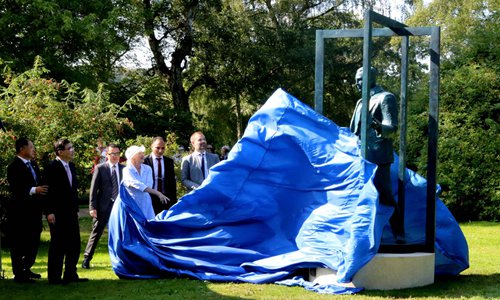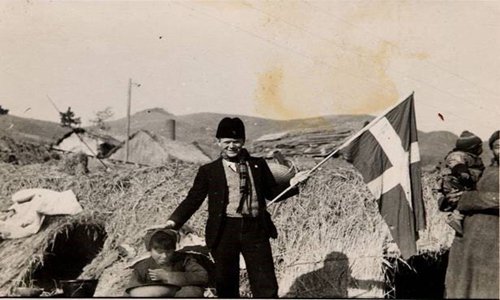Bernhard Arp Sindberg, a Danish Schindler, commemorated with new statue

Danish Queen Margrethe II unveils the statue of Danish hero Bernhard Arp Sindberg on Saturday morning at the Mindeparken memorial park in Aarhus, Denmark. Photo: Courtesy of Per Ryolf

The statue of Bernhard Arp Sindberg Photo: Courtesy of Per Ryolf

Bernhard Arp Sindberg Photo: Courtesy of Danish Embassy in Beijing
While Monday marked the 74th anniversary of the end of the War of Resistance against Japanese Aggression (1931-45) and the World Anti-Fascist War, Danish Queen Margrethe II unveiled a three-meter tall bronze statue of Danish hero Bernhard Arp Sindberg on Saturday morning at the Mindeparken memorial park in Aarhus, Denmark. It is estimated that the Danish hero saved the lives of more than 20,000 Chinese during the Nanjing Massacre.
Sindberg was born in Aarhus, Denmark's second largest city. The statue was made by Chinese artists Shang Rong and Fu Licheng and Danish artist Lene Desmentik and is a gift to Aarhus from the city of Nanjing, the capital of East China's Jiangsu Province.
As an adventurous young man, Sindberg traveled widely. He was just 26 years old when he traveled to China and landed a job at a cement factory in Nanjing, where he worked as a guard. He was still in the city when the Japanese military invaded in December 1937.
The six weeks of atrocities against the city were filled with torture, rape and murder. The Japanese troops brutally took the lives of about 300,000 Chinese civilians and unarmed soldiers.
Together with Karl Günther, a German engineer who also worked at the factory, Sindberg decided to open the factory gates to the people of Nanjing, and after just a few days thousands had taken refuge in the factory. To ward off the Japanese bombs, Sindberg painted a gigantic Danish flag on the roof of the cement factory and raised both the Danish flag and two German swastika flags-which had a deterring effect on the Japanese troops.
Sindberg and Günther set up a makeshift hospital for the Chinese refugees, and repeatedly risked their own lives by driving out into the occupied city to collect food, medicine and supplies for them from the Red Cross.
Meanwhile, Sindberg recorded the inhumanity of the Japanese troops with photographs and letters, unveiling the truth of the Nanjing Massacre to the international community. A photo exhibition opened on Saturday in Nanjing as well as Aarhus to commemorate Sindberg and the friendship between the Chinese and Danish people.